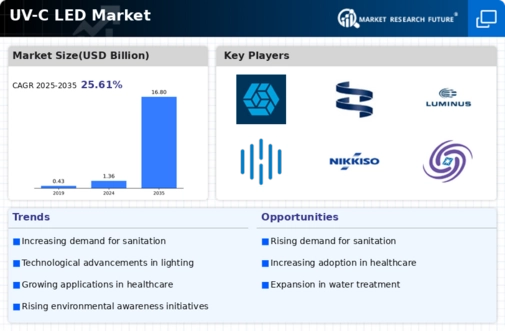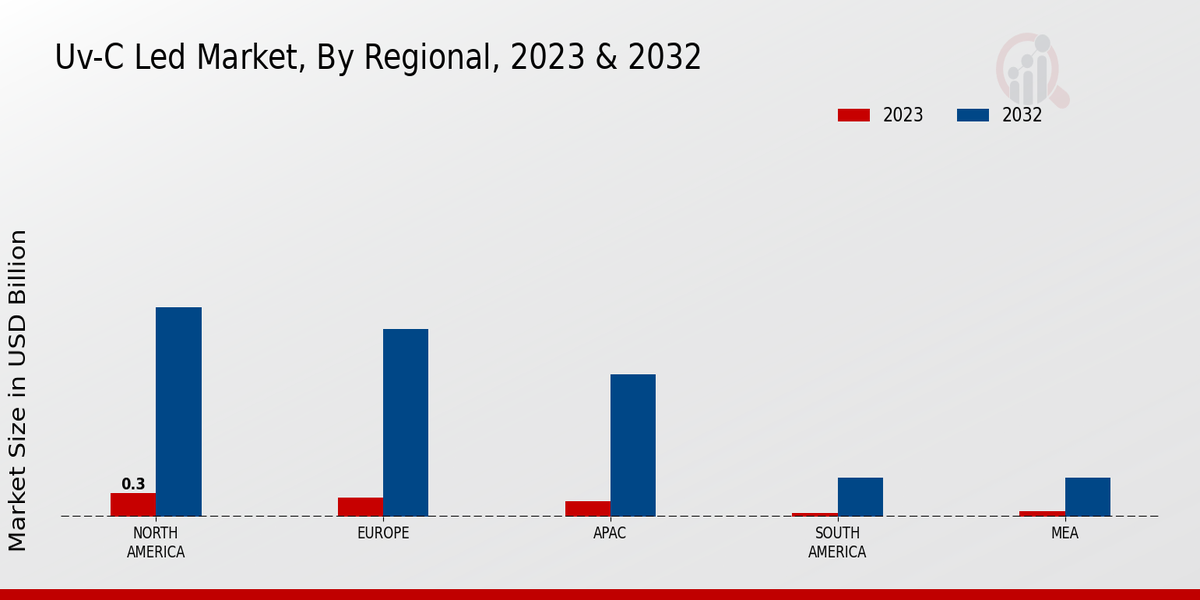Market Growth Projections
The Global UV-C LED Market Industry is projected to experience substantial growth over the next decade. In 2024, the market is estimated to be valued at 1.36 USD Billion, with expectations to reach 16.8 USD Billion by 2035. This remarkable growth trajectory suggests a compound annual growth rate (CAGR) of 25.67% from 2025 to 2035. Such projections indicate a robust demand for UV-C LED technology across various applications, driven by factors such as increased awareness of disinfection needs and technological advancements. The anticipated growth reflects the market's potential to become a cornerstone in the disinfection landscape, highlighting the importance of UV-C LEDs in addressing contemporary sanitation challenges.
Diverse Applications Across Industries
The versatility of UV-C LED technology contributes significantly to the growth of the Global UV-C LED Market Industry. Its applications span various sectors, including healthcare, food and beverage, air purification, and surface disinfection. This diversity allows for a broad customer base, as different industries recognize the benefits of UV-C disinfection. For example, the healthcare sector utilizes UV-C LEDs for sterilizing medical equipment, while the food industry employs them for surface sanitation. This wide-ranging applicability not only drives demand but also encourages innovation, as companies explore new uses for UV-C technology. As industries continue to discover the potential of UV-C LEDs, market growth is anticipated to accelerate.
Technological Advancements in UV-C LED
Technological advancements play a pivotal role in the evolution of the Global UV-C LED Market Industry. Innovations in materials and manufacturing processes have led to the development of more efficient and durable UV-C LEDs. These advancements not only improve the performance of UV-C LEDs but also reduce costs, making them more accessible to a broader range of applications. As manufacturers continue to invest in research and development, the market is likely to witness an influx of new products that enhance the effectiveness of UV-C disinfection. This continuous innovation is expected to drive market growth, as industries seek to leverage the latest technologies to improve their disinfection protocols.
Regulatory Support for UV-C Technologies
Regulatory support significantly influences the Global UV-C LED Market Industry, as governments worldwide implement stringent regulations regarding sanitation and disinfection. These regulations often mandate the use of effective disinfection technologies in various sectors, including healthcare and food safety. For instance, the introduction of guidelines promoting UV-C disinfection methods has encouraged industries to adopt UV-C LED solutions. This regulatory push not only fosters market growth but also enhances consumer confidence in UV-C technologies. As regulations evolve, the market is expected to expand, with stakeholders increasingly recognizing the importance of compliance in maintaining public health standards.
Growing Demand for Disinfection Solutions
The Global UV-C LED Market Industry experiences a notable surge in demand for disinfection solutions across various sectors, including healthcare, food processing, and water treatment. As awareness of hygiene and sanitation increases, industries are increasingly adopting UV-C LED technology for its efficacy in eliminating pathogens. In 2024, the market is projected to reach 1.36 USD Billion, driven by the need for effective disinfection methods. This trend is expected to continue, with the market potentially expanding to 16.8 USD Billion by 2035, reflecting a robust CAGR of 25.67% from 2025 to 2035. Such growth underscores the critical role of UV-C LEDs in enhancing public health and safety.
Increased Awareness of Environmental Sustainability
The Global UV-C LED Market Industry is witnessing a shift towards environmentally sustainable solutions, driven by increasing awareness of ecological impacts. UV-C LEDs are recognized for their energy efficiency and reduced chemical usage compared to traditional disinfection methods. This aligns with global sustainability goals, as industries seek to minimize their carbon footprint. The adoption of UV-C LEDs not only meets disinfection needs but also supports environmental initiatives, making them an attractive option for businesses. As sustainability becomes a priority for consumers and organizations alike, the market is likely to benefit from this trend, further propelling its growth in the coming years.















